2014 MITSUBISHI OUTLANDER SPORT stop start
[x] Cancel search: stop startPage 184 of 388
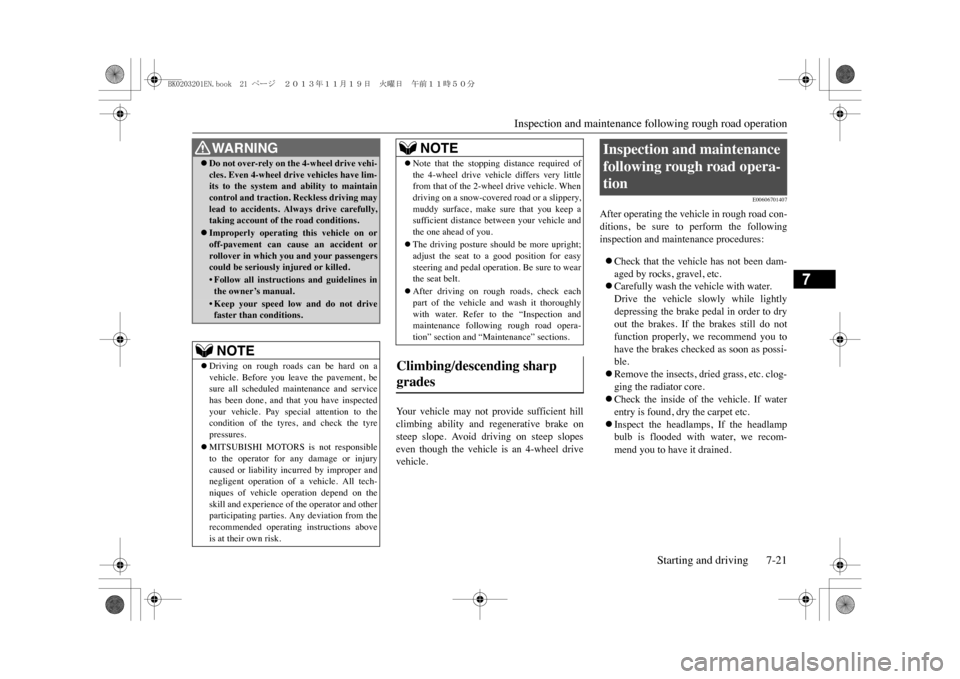
Inspection and maintenance following rough road operation
Starting and driving 7-21
7
Yo u r v e h i c l e m a y n o t p r o v i d e s u f f i c i e n t h i l lclimbing ability and regenerative brake onsteep slope. Avoid driving on steep slopeseven though the vehicle is an 4-wheel drivevehicle.
E00606701407
After operating the vehicle in rough road con-ditions, be sure to perform the followinginspection and maintenance procedures:�zCheck that the vehicle has not been dam-aged by rocks, gravel, etc.�zCarefully wash the vehicle with water.Drive the vehicle slowly while lightlydepressing the brake pedal in order to dryout the brakes. If the brakes still do notfunction properly, we recommend you tohave the brakes checked as soon as possi-ble.�zRemove the insects, dried grass, etc. clog-ging the radiator core.�zCheck the inside of the vehicle. If waterentry is found, dry the carpet etc.�zInspect the headlamps, If the headlampbulb is flooded with water, we recom-mend you to have it drained.
WA R N I N G�zDo not over-rely on the 4-wheel drive vehi-cles. Even 4-wheel drive vehicles have lim-its to the system and ability to maintaincontrol and traction.
Reckless driving may
lead to accidents. Always drive carefully,taking account of the road conditions.�zImproperly operating this vehicle on oroff-pavement can cause an accident orrollover in which you and your passengerscould be seriously injured or killed.•Follow all instructions and guidelines inthe owner’s manual.•Keep your speed low and do not drivefaster than conditions.NOTE
�zDriving on rough roads can be hard on avehicle. Before you leave the pavement, besure all scheduled maintenance and servicehas been done, and that
you have inspected
your vehicle. Pay special attention to thecondition of the tyres, and check the tyrepressures.�zMITSUBISHI MOTORS
is not responsible
to the operator for any damage or injurycaused or liability incurred by improper andnegligent operation of a vehicle. All tech-niques of vehicle operation depend on theskill and experience of the operator and otherparticipating parties.
Any deviation from the
recommended operating instructions aboveis at their own risk.
�zNote that the stopping
distance required of
the 4-wheel drive vehicle differs very littlefrom that of the 2-wheel
drive vehicle. When
driving on a snow-covered
road or a slippery,
muddy surface, make sure that you keep asufficient distance between your vehicle andthe one ahead of you.�zThe driving posture s
hould be more upright;
adjust the seat to a good position for easysteering and pedal operati
on. Be sure to wear
the seat belt.�zAfter driving on rough roads, check eachpart of the vehicle and wash it thoroughlywith water. Refer to the “Inspection andmaintenance following rough road opera-tion” section and “Maintenance” sections.
Climbing/descending sharp grades
NOTE
Inspection and maintenance following rough road opera-tion
BK0203201EN.book 21 ページ 2013年11月19日 火曜日 午前11時50分
Page 186 of 388
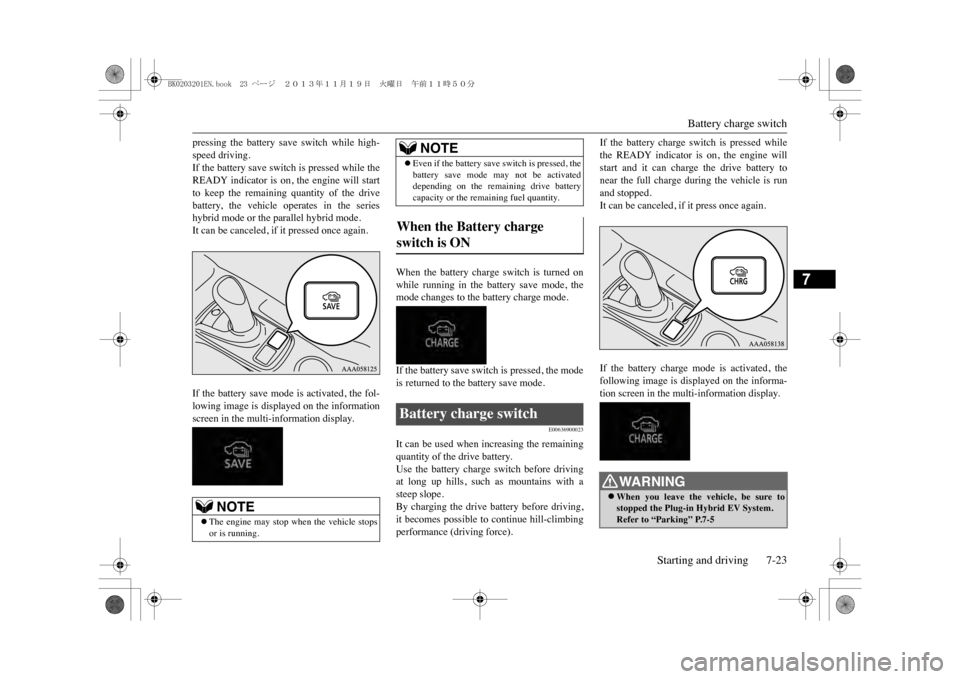
Battery charge switch
Starting and driving 7-23
7
pressing the battery save switch while high-speed driving.If the battery save switch is pressed while theREADY indicator is on, the engine will startto keep the remaining quantity of the drivebattery, the vehicle operates in the serieshybrid mode or the parallel hybrid mode.It can be canceled, if it pressed once again.If the battery save mode is activated, the fol-lowing image is displayed on the informationscreen in the multi-information display.
When the battery charge switch is turned onwhile running in the battery save mode, themode changes to the battery charge mode.If the battery save switch is pressed, the modeis returned to the battery save mode.
E00636900023
It can be used when increasing the remainingquantity of the drive battery.Use the battery charge switch before drivingat long up hills, such as mountains with asteep slope.By charging the drive battery before driving,it becomes possible to continue hill-climbingperformance (driving force).
If the battery charge switch is pressed whilethe READY indicator is on, the engine willstart and it can charge the drive battery tonear the full charge during the vehicle is runand stopped.It can be canceled, if it press once again. If the battery charge mode is activated, thefollowing image is displayed on the informa-tion screen in the multi-information display.
NOTE
�zThe engine may stop when the vehicle stopsor is running.
�zEven if the battery save
switch is pressed, the
battery save mode may not be activateddepending on the remaining drive batterycapacity or the remaining fuel quantity.
When the Battery charge switch is ON Battery charge switch
NOTE
WA R N I N G�zWhen you leave the vehicle, be sure tostopped the Plug-in Hybrid EV System.Refer to “Parking” P.7-5
BK0203201EN.book 23 ページ 2013年11月19日 火曜日 午前11時50分
Page 187 of 388
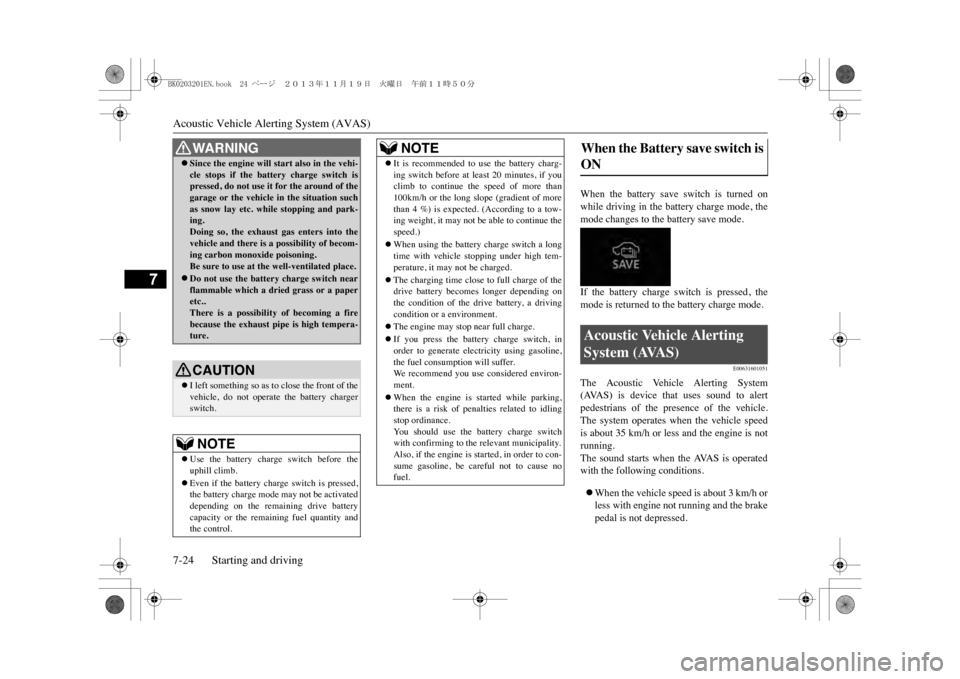
Acoustic Vehicle Alerting System (AVAS)7-24 Starting and driving
7
When the battery save switch is turned onwhile driving in the battery charge mode, themode changes to the battery save mode.If the battery charge switch is pressed, themode is returned to the battery charge mode.
E00631601051
The Acoustic Vehicle Alerting System(AVAS) is device that uses sound to alertpedestrians of the presence of the vehicle.The system operates when the vehicle speedis about 35 km/h or less and the engine is notrunning.The sound starts when the AVAS is operatedwith the following conditions.�zWhen the vehicle speed is about 3 km/h orless with engine not running and the brakepedal is not depressed.
�zSince the engine will start also in the vehi-cle stops if the batt
ery charge switch is
pressed, do not use it for the around of thegarage or the vehicle
in the situation such
as snow lay etc. while stopping and park-ing.Doing so, the exhaust gas enters into thevehicle and there is a possibility of becom-ing carbon monoxide poisoning.Be sure to use at the well-ventilated place.�zDo not use the battery charge switch nearflammable which a drie
d grass or a paper
etc..There is a possibility of becoming a firebecause the exhaust pipe is high tempera-ture.CAUTION�zI left something so as to close the front of thevehicle, do not operate the battery chargerswitch.NOTE
�zUse the battery charge switch before theuphill climb.�zEven if the battery charge switch is pressed,the battery charge mode may not be activateddepending on the remaining drive batterycapacity or the remaining fuel quantity andthe control.WA R N I N G
�zIt is recommended to use the battery charg-ing switch before at least 20 minutes, if youclimb to continue the speed of more than100km/h or the long slope (gradient of morethan 4 %) is expected. (According to a tow-ing weight, it may not be able to continue thespeed.)�zWhen using the battery charge switch a longtime with vehicle
stopping under high tem-
perature, it may not be charged.�zThe charging time close to full charge of thedrive battery becomes longer depending onthe condition of the drive battery, a drivingcondition or a environment.�zThe engine may stop near full charge.�zIf you press the battery charge switch, inorder to generate elec
tricity using gasoline,
the fuel consumption will suffer.We r e c o m m e n d y o u u s e c o n s i d e r e d e n v i r o n -ment.�zWhen the engine is started while parking,there is a risk of penalties related to idlingstop ordinance.Yo u s h o u l d u s e t h e b a t t e r y c h a r g e s w i t c hwith confirming to the relevant municipality.Also, if the engine is started, in order to con-sume gasoline, be careful not to cause nofuel.NOTE
When the Battery save switch is ON Acoustic Vehicle Alerting System (AVAS)
BK0203201EN.book 24 ページ 2013年11月19日 火曜日 午前11時50分
Page 189 of 388
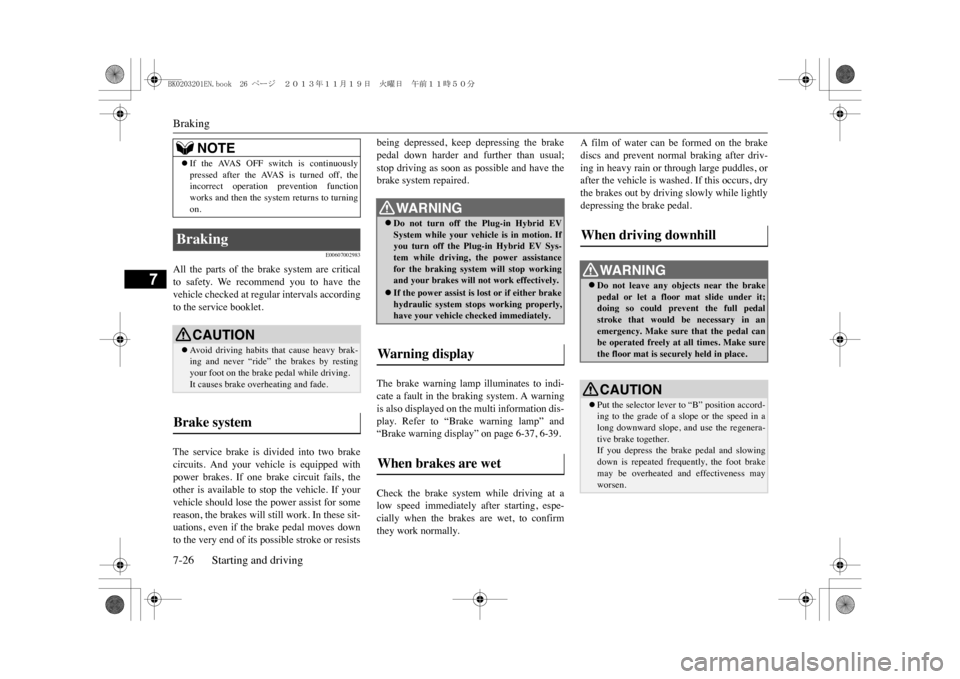
Braking7-26 Starting and driving
7
E00607002983
All the parts of the brake system are criticalto safety. We recommend you to have thevehicle checked at regular intervals accordingto the service booklet.The service brake is divided into two brakecircuits. And your vehicle is equipped withpower brakes. If one brake circuit fails, theother is available to stop the vehicle. If yourvehicle should lose the power assist for somereason, the brakes will still work. In these sit-uations, even if the brake pedal moves downto the very end of its possible stroke or resists
being depressed, keep depressing the brakepedal down harder and further than usual;stop driving as soon as possible and have thebrake system repaired.The brake warning lamp illuminates to indi-cate a fault in the braking system. A warningis also displayed on the multi information dis-play. Refer to “Brake warning lamp” and“Brake warning display” on page 6-37, 6-39.Check the brake system while driving at alow speed immediately after starting, espe-cially when the brakes are wet, to confirmthey work normally.
A film of water can be formed on the brakediscs and prevent normal braking after driv-ing in heavy rain or through large puddles, orafter the vehicle is washed. If this occurs, drythe brakes out by driving slowly while lightlydepressing the brake pedal.
�zIf the AVAS OFF switch is continuouslypressed after the AVAS is turned off, theincorrect operation prevention functionworks and then the system returns to turningon.
Braking
CAUTION�zAv o i d d r i v i n g h a b i t s t h a t c a u s e h e a v y b r a k -ing and never “ride” the brakes by restingyour foot on the brake pedal while driving.It causes brake overheating and fade.
Brake system
NOTE
WA R N I N G�zDo not turn off the Plug-in Hybrid EVSystem while your vehicle is in motion. Ifyou turn off the Plug-in Hybrid EV Sys-tem while driving, the power assistancefor the braking system will stop workingand your brakes will not work effectively.�zIf the power assist is lost or if either brakehydraulic system stops working properly,have your vehicle checked immediately.
Warn i ng d is p l a y When brakes are wet
When driving downhill
WA R N I N G�zDo not leave any obje
cts near the brake
pedal or let a floor mat slide under it;doing so could prevent the full pedalstroke that would be necessary in anemergency. Make sure that the pedal canbe operated freely at all times. Make surethe floor mat is securely held in place.CAUTION�zPut the selector lever to “B” position accord-ing to the grade of a slope or the speed in along downward slope, and use the regenera-tive brake together. If you depress the brake pedal and slowingdown is repeated frequently, the foot brakemay be overheated and effectiveness mayworsen.
BK0203201EN.book 26 ページ 2013年11月19日 火曜日 午前11時50分
Page 190 of 388
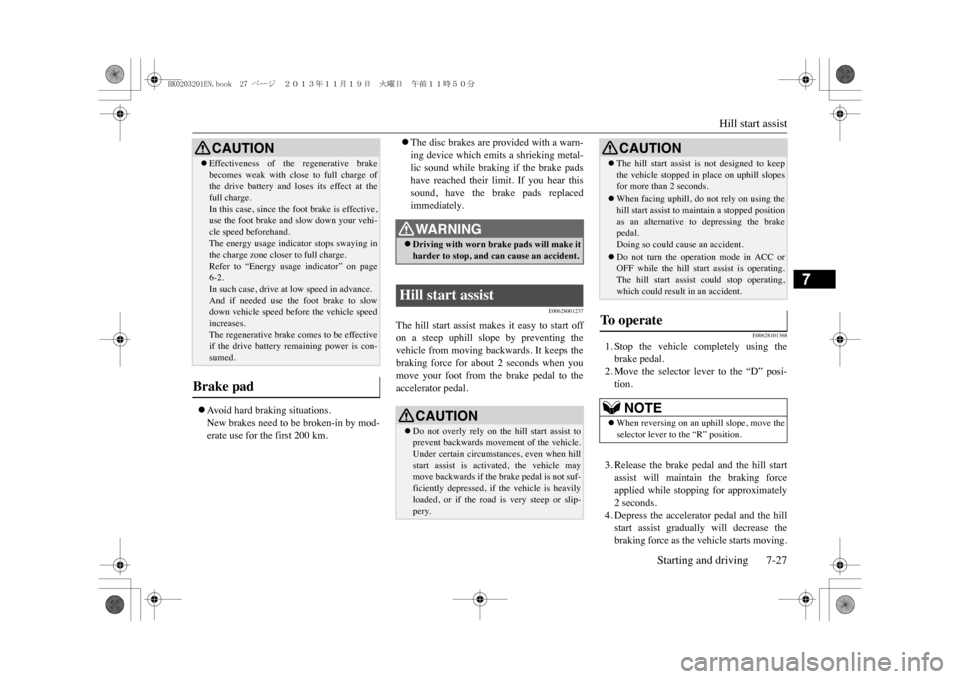
Hill start assist
Starting and driving 7-27
7
�zAv o i d h a r d b r a k i n g s i t u a t i o n s .New brakes need to be broken-in by mod-erate use for the first 200 km.
�zThe disc brakes are provided with a warn-ing device which emits a shrieking metal-lic sound while braking if the brake padshave reached their limit. If you hear thissound, have the brake pads replacedimmediately.
E00628001237
The hill start assist makes it easy to start offon a steep uphill slope by preventing thevehicle from moving backwards. It keeps thebraking force for about 2 seconds when youmove your foot from the brake pedal to theaccelerator pedal.
E00628101368
1. Stop the vehicle completely using thebrake pedal.2. Move the selector lever to the “D” posi-tion.3. Release the brake pedal and the hill startassist will maintain the braking forceapplied while stopping for approximately2 seconds.4. Depress the accelerator pedal and the hillstart assist gradually will decrease thebraking force as the vehicle starts moving.
�zEffectiveness of the
regenerative brake
becomes weak with close to full charge ofthe drive battery and loses its effect at thefull charge.In this case, since the
foot brake is effective,
use the foot brake and slow down your vehi-cle speed beforehand.The energy usage indicator stops swaying inthe charge zone closer to full charge.Refer to “Energy usag
e indicator” on page
6-2.In such case, drive at low speed in advance.And if needed use th
e foot brake to slow
down vehicle speed before the vehicle speedincreases.The regenerative brake comes to be effectiveif the drive battery re
maining power is con-
sumed.
Brake pad
CAUTION
WA R N I N G�zDriving with worn brake pads will make itharder to stop, and can cause an accident.
Hill start assist
CAUTION�zDo not overly rely on the hill start assist toprevent backwards movement of the vehicle.Under certain circumstances, even when hillstart assist is activated, the vehicle maymove backwards if the brake pedal is not suf-ficiently depressed, if the vehicle is heavilyloaded, or if the road is very steep or slip-pery.
�zThe hill start assist is not designed to keepthe vehicle stopped in place on uphill slopesfor more than 2 seconds.�zWhen facing uphill, do not rely on using thehill start assist to maintain a stopped positionas an alternative to depressing the brakepedal.Doing so could cause an accident.�zDo not turn the operation mode in ACC orOFF while the hill start assist is operating.The hill start assist could stop operating,which could result in an accident.
To o p e r a t e
NOTE
�zWhen reversing on an uphill slope, move theselector lever to the “R” position.CAUTION
BK0203201EN.book 27 ページ 2013年11月19日 火曜日 午前11時50分
Page 191 of 388
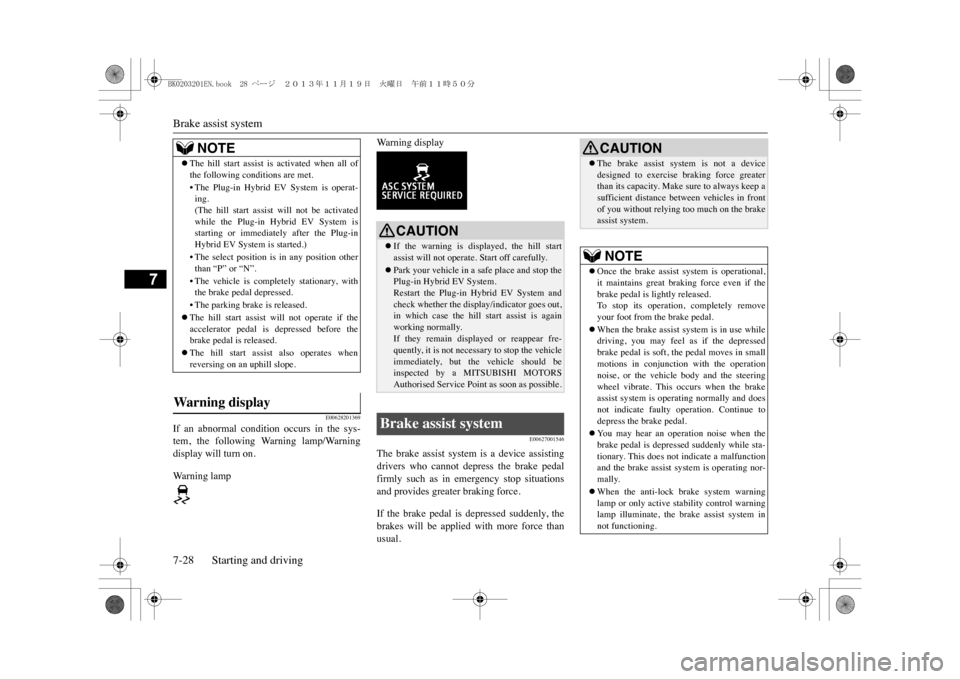
Brake assist system7-28 Starting and driving
7
E00628201369
If an abnormal condition occurs in the sys-tem, the following Warning lamp/Warningdisplay will turn on.Wa r n i n g l a m p
Warning display
E00627001546
The brake assist system
is a device assisting
drivers who cannot depress the brake pedalfirmly such as in emergency stop situationsand provides greater braking force.If the brake pedal is depressed suddenly, thebrakes will be applied with more force thanusual.
NOTE
�zThe hill start assist is activated when all ofthe following conditions are met.•The Plug-in Hybrid EV System is operat-ing.(The hill start assist will not be activatedwhile the Plug-in Hybrid EV System isstarting or immediately after the Plug-inHybrid EV System is started.)• The select position is in any position otherthan “P” or “N”.•The vehicle is completely stationary, withthe brake pedal depressed.• The parking brake is released.�zThe hill start assist will not operate if theaccelerator pedal is depressed before thebrake pedal is released.�zThe hill start assist also operates whenreversing on an uphill slope.
Warn in g di s p lay
CAUTION�zIf the warning is displayed, the hill startassist will not operate. Start off carefully.�zPark your vehicle in a safe place and stop thePlug-in Hybrid EV System.Restart the Plug-in Hybrid EV System andcheck whether the disp
lay/indicator goes out,
in which case the hill start assist is againworking normally.If they remain displayed or reappear fre-quently, it is not necessa
ry to stop the vehicle
immediately, but the vehicle should beinspected by a MITSUBISHI MOTORSAuthorised Service Poin
t as soon as possible.
Brake assist system
CAUTION�zThe brake assist system is not a devicedesigned to exercise braking force greaterthan its capacity. Make sure to always keep asufficient distance be
tween vehicles in front
of you without relying too much on the brakeassist system.NOTE
�zOnce the brake assist system is operational,it maintains great braking force even if thebrake pedal is lightly released.To s t o p i t s o p e r a t i o n , c o m p l e t e l y r e m o v eyour foot from the brake pedal.�zWhen the brake assist system is in use whiledriving, you may feel as if the depressedbrake pedal is soft, the pedal moves in smallmotions in conjunction
with the operation
noise, or the vehicle body and the steeringwheel vibrate. This occurs when the brakeassist system is ope
rating normally and does
not indicate faulty operation. Continue todepress the brake pedal.�zYo u m a y h e a r a n o p e r a t i o n n o i s e w h e n t h ebrake pedal is depressed suddenly while sta-tionary. This does not indicate a malfunctionand the brake assist system is operating nor-mally.�zWhen the anti-lock brake system warninglamp or only active stability control warninglamp illuminate, the brake assist system innot functioning.
BK0203201EN.book 28 ページ 2013年11月19日 火曜日 午前11時50分
Page 192 of 388
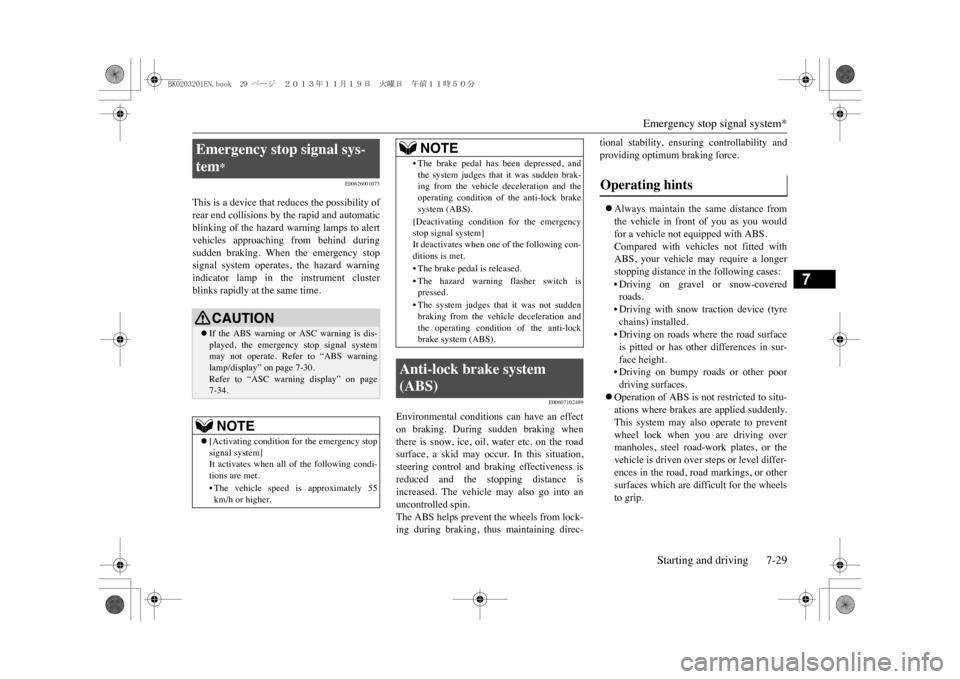
Emergency stop signal system*
Starting and driving 7-29
7
E00626001073
This is a device that reduces the possibility ofrear end collisions by the rapid and automaticblinking of the hazard warning lamps to alertvehicles approaching from behind duringsudden braking. When the emergency stopsignal system operates, the hazard warningindicator lamp in the instrument clusterblinks rapidly at the same time.
E00607102489
Environmental conditions can have an effecton braking. During sudden braking whenthere is snow, ice, oil, water etc. on the roadsurface, a skid may occur. In this situation,steering control and braking effectiveness isreduced and the stopping distance isincreased. The vehicle may also go into anuncontrolled spin.The ABS helps prevent the wheels from lock-ing during braking, thus maintaining direc-
tional stability, ensuring controllability andproviding optimum braking force.�zAlways maintain the same distance fromthe vehicle in front of you as you wouldfor a vehicle not equipped with ABS.Compared with vehicles not fitted withABS, your vehicle may require a longerstopping distance in the following cases:•Driving on gravel or snow-coveredroads.• Driving with snow traction device (tyrechains) installed.•Driving on roads where the road surfaceis pitted or has other differences in sur-face height.• Driving on bumpy roads or other poordriving surfaces.
�zOperation of ABS is not restricted to situ-ations where brakes are applied suddenly.This system may also operate to preventwheel lock when you are driving overmanholes, steel road-work plates, or thevehicle is driven over steps or level differ-ences in the road, road markings, or othersurfaces which are difficult for the wheelsto grip.
Emergency stop signal sys-tem
*CAUTION�zIf the ABS warning or ASC warning is dis-played, the emergency stop signal systemmay not operate. Refer to “ABS warninglamp/display” on page 7-30.Refer to “ASC warn
ing display” on page
7-34.NOTE
�z[Activating condition for the emergency stopsignal system]It activates when all
of the following condi-
tions are met.•The vehicle speed is approximately 55km/h or higher.
•The brake pedal has been depressed, andthe system judges that it was sudden brak-ing from the vehicle deceleration and theoperating condition of the anti-lock brakesystem (ABS).[Deactivating condition for the emergencystop signal system]It deactivates when one of the following con-ditions is met.•The brake pedal is released.• The hazard warning flasher switch ispressed.•The system judges that it was not suddenbraking from the vehicle deceleration andthe operating condition of the anti-lockbrake system (ABS).
Anti-lock brake system (ABS)
NOTE
Operating hints
BK0203201EN.book 29 ページ 2013年11月19日 火曜日 午前11時50分
Page 193 of 388
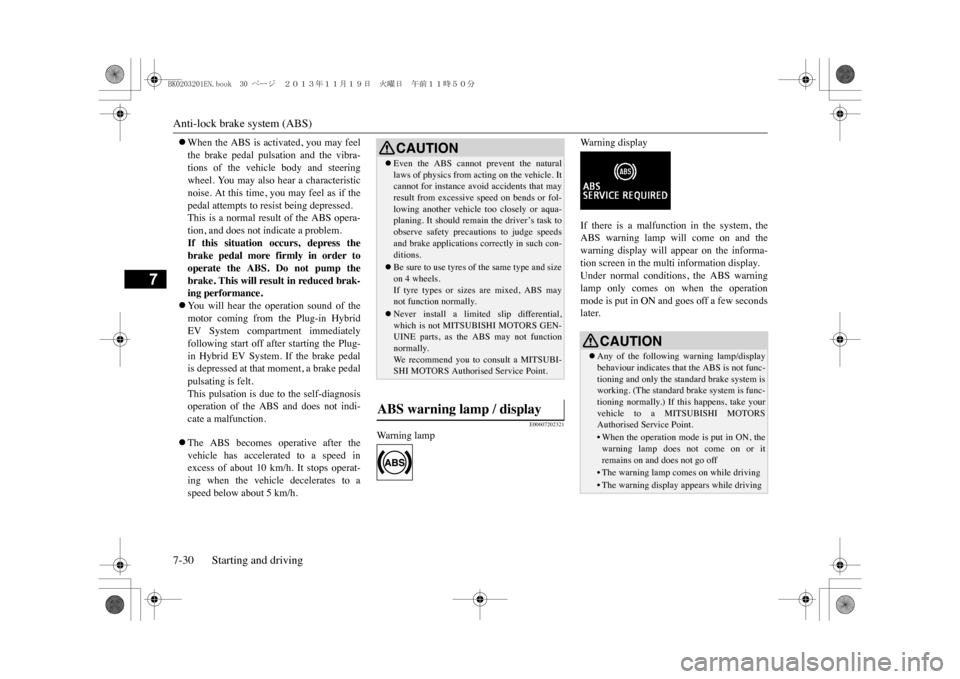
Anti-lock brake system (ABS)7-30 Starting and driving
7
�zWhen the ABS is activated, you may feelthe brake pedal pulsation and the vibra-tions of the vehicle body and steeringwheel. You may also hear a characteristicnoise. At this time, you may feel as if thepedal attempts to resist being depressed.This is a normal result of the ABS opera-tion, and does not indicate a problem.If this situation occurs, depress thebrake pedal more firmly in order tooperate the ABS. Do not pump thebrake. This will result in reduced brak-ing performance.�zYo u w i l l h e a r t h e o p e r a t i o n s o u n d o f t h emotor coming from the Plug-in HybridEV System compartment immediatelyfollowing start off after starting the Plug-in Hybrid EV System. If the brake pedalis depressed at that moment, a brake pedalpulsating is felt.This pulsation is due to the self-diagnosisoperation of the ABS and does not indi-cate a malfunction.�zThe ABS becomes operative after thevehicle has accelerated to a speed inexcess of about 10 km/h. It stops operat-ing when the vehicle decelerates to aspeed below about 5 km/h.
E00607202321
Wa r n i n g l a m p
Wa r n i n g d i s p l a yIf there is a malfunction in the system, theABS warning lamp will come on and thewarning display will appear on the informa-tion screen in the multi information display.Under normal conditions, the ABS warninglamp only comes on when the operationmode is put in ON and goes off a few secondslater.
CAUTION�zEven the ABS cannot prevent the naturallaws of physics from acting on the vehicle. Itcannot for instance avoi
d accidents that may
result from excessive speed on bends or fol-lowing another vehicle
too closely or aqua-
planing. It should remain the driver’s task toobserve safety precau
tions to judge speeds
and brake applications correctly in such con-ditions.�zBe sure to use tyres of the same type and sizeon 4 wheels.If tyre types or sizes are mixed, ABS maynot function normally.�zNever install a limited slip differential,which is not MITSUBISHI MOTORS GEN-UINE parts, as the
ABS may not function
normally.We recommend you to consult a MITSUBI-SHI MOTORS Authorised Service Point.
ABS warning lamp / display
CAUTION�zAny of the following warning lamp/displaybehaviour indicates that
the ABS is not func-
tioning and only the standard brake system isworking. (The standard
brake system is func-
tioning normally.) If this happens, take yourvehicle to a MITSUBISHI MOTORSAuthorised Service Point.•When the operation mode is put in ON, thewarning lamp does not come on or itremains on and does not go off•The warning lamp comes on while driving•The warning display
appears while driving
BK0203201EN.book 30 ページ 2013年11月19日 火曜日 午前11時50分